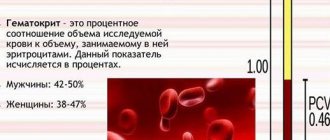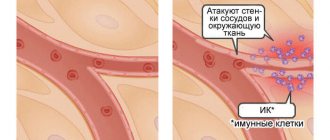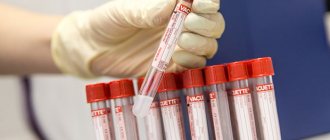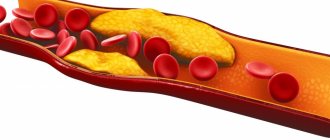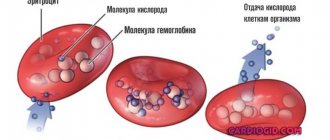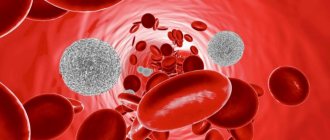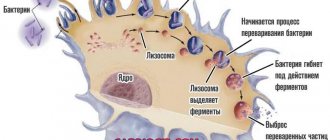Published: 03/30/2021 17:00:00 Updated: 03/30/2021
Erythrocytes are red blood cells, the most numerous blood cells. Formally, they are not cells, since during the process of maturation they lose many of the structures necessary for cells. For example, they lack nuclei and do not synthesize any protein molecules, unlike other cells in the body. So the name “cell” in this case is used for convenience. Red blood cells are formed in the bone marrow and constantly circulate in the body, performing the most important function of maintaining life - they carry oxygen from the lungs to tissues and organs and remove carbon dioxide.
In addition to red blood cells, blood contains plasma, platelets, and leukocytes. However, the number of red blood cells is so large that just a couple of drops of blood contains about one billion of these cells. They make up about 40% of the total blood volume. Actually, it is red blood cells that give our blood its characteristic red color due to its hemoglobin content.
Red blood cells do not last forever, they wear out over time and eventually die. The average life cycle of a red blood cell is approximately 120 days—a total of four months. However, do not worry, the bone marrow is constantly producing new cells and maintaining the required level of red blood cells. Various unfavorable circumstances can reduce or, conversely, increase their reproduction rate and affect their life expectancy - thus, the balance of blood composition is disrupted. An increase or decrease in red blood cells is associated with various pathological conditions. Let's consider this issue in more detail.
Red blood cells are normal
The normal limits vary depending on gender, age and other characteristics.
So, for an adult man it ranges from 4.0 to 5.1 × 10¹² units per liter of blood, and for women - 3.7 to 4.7 × 10¹² per liter.
In pregnant women, red blood cells may decrease to 3–3.5 x 10¹² per liter.
In children under one year of age, the concentration of red blood cells is constantly changing, so to assess the composition of their blood there is a special table that doctors use when interpreting tests.
In childhood, after one year there are still slight deviations from the “adult” norm, but by adolescence the level of red blood cells levels out.
Anemia in men and women
Anemia is one of the most common diseases among the adult population of the Earth today. Risk groups for developing anemia include:
- lovers of vegetarian cuisine.
- patients suffering from large blood losses due to the physiological characteristics of the body or a number of chronic diseases.
- pregnant women.
- professional athletes.
Anemia in men is diagnosed in the presence of malignant neoplasms or hidden bleeding of the gastrointestinal tract, peptic ulcer, hemorrhoids and other pathologies. A decrease in the level of hemoglobin in a woman’s blood can be associated with heavy menstruation, pregnancy and lactation, and a period of hormonal changes during menopause. Varying degrees of anemia also appear in children due to lack of adequate nutrition, impaired absorption of iron in the gastrointestinal tract, gastritis or parasitic diseases, limited exposure to fresh air and physical inactivity.
Elevated red blood cells
Red blood cells can be elevated due to many reasons, ranging from banal dehydration to erythremia - chronic leukemia.
Therefore, if there are any deviations in test results, you should consult a specialist to determine the cause. An increase in the number of red blood cells is called erythrocytosis, which can be: 1. Primary. A rare hereditary disease characterized by loss of energy, dizziness and darker color of the mucous membranes. 2. Secondary. Caused by other diseases or conditions (for example, smoking or staying in high mountains) and is associated with oxygen starvation of cells.
Thus, the following reasons for the increase in red blood cells can be identified:
- Dehydration. When the volume of fluid in the body is reduced, the percentage of red blood cells (and other blood cells) artificially increases.
- A lack of oxygen, which the body tries to compensate by producing more red blood cells.
- Congenital heart defect. If the heart cannot pump blood effectively, the amount of oxygen reaching the tissues is reduced. The body creates more red blood cells to compensate for oxygen deprivation.
- Genetic causes (changes in sensitivity to oxygen, impaired release of oxygen by hemoglobin).
- Polycythemia vera is a rare disease in which the body produces too many red blood cells.
Increased production of red blood cells can cause blood to thicken, slow blood flow, and related problems (eg, headaches, dizziness, vision problems, excessive blood clotting).
Often, elevated red blood cell levels are due to dehydration, hot weather, extreme stress, or excessive exercise. A pathological increase in red blood cells is a fairly rare pathology. Much more often, patients encounter reduced levels.
Description of the causes of erythrocytosis
An excess of red blood cells in the blood plasma is called erythrocytosis. As a result, the blood begins to thicken and moves through the capillaries with difficulty. Red blood cell production spontaneously increases in the body when oxygen levels in cells decrease. Lack of oxygen can be caused by congenital pathology of the heart muscle, heart failure, hemoglobinopathy, chronic obstructive pulmonary disease, and excessive smoking.
It is possible to regulate the formation of red blood cells with the help of certain drugs. These include anabolic steroids, erythropoietin protein and some groups of antibiotics intended for the treatment of infectious and inflammatory processes in hematopoiesis.
The consequence of an increase in red blood cells in blood cells can be dehydration, which occurs as a result of an increase in temperature in the body, the occurrence of gag reflexes and loose stools. During such deviations, the concentration of red blood cells increases, but their number does not change.
Decreased red blood cells
The main symptoms of low red blood cell count are:
- Weakness or fatigue.
- Lack of energy.
- Paleness of the skin.
Reduced red blood cells are a relatively common pathology.
A low number of red blood cells and/or hemoglobin is called anemia. If there are few red blood cells, there is correspondingly less hemoglobin in the bloodstream, which carries oxygen. Thus, the body experiences oxygen starvation, and we feel weakness, drowsiness, loss of vitality, and dizziness. Due to anemia, hair falls out, the skin becomes pale and dry. There are many forms of anemia, each with its own cause. Anemia can be temporary or acquired; depending on severity - from mild to severe. According to a 2015 publication in The Lancet, about one-third of the world's population is anemic.
The most common causes of low red blood cells are:
- Unbalanced diet with deficiency of iron, vitamin B12 or folic acid.
- Damage to the bone marrow (toxins, radiation or chemotherapy, infection, certain medications).
- Any bone marrow disease.
- Chronic inflammatory processes.
- Bleeding in the digestive tract (for example, from ulcers, polyps, colon cancer).
- Heavy menstrual bleeding.
- Trauma with massive blood loss.
- Conditions that cause the destruction of red blood cells (for example, hemolytic anemia caused by autoimmune processes or defects in the red blood cells themselves).
- Kidney failure – serious kidney pathologies lead to a decrease in erythropoietin (or hematopoietin), a kidney hormone that promotes the production of red blood cells.
The risk of anemia is higher in the following groups:
- children aged from 6 months to 2 years;
- pregnant or recently given birth women;
- following a diet low in vitamins, minerals and iron, red meat;
- patients who regularly take medications that cause inflammation of the gastric mucosa (for example, ibuprofen);
- having a family history of hereditary anemia such as sickle cell anemia or thalassemia;
- patients with an intestinal disorder that affects the absorption of nutrients (eg, Crohn's disease);
- have recently experienced major blood loss due to surgery or injury;
- people with chronic diseases (HIV, diabetes, kidney disease, cancer, rheumatoid arthritis, heart failure, liver disease).
Cases of complications
Sometimes not only red blood cells are found in the urine, but also other blood cells - leukocytes, as well as protein compounds. This is clearly a pathological condition, which indicates the development of pathogenic processes. As a rule, they are associated with the following reasons:
- hemorrhagic cystitis;
- urolithiasis;
- inflammation in the kidneys;
- tuberculosis;
- tumors of various nature in the urinary tract.
It is important to take action immediately and get tested. Otherwise, kidney pathology can become chronic, resulting in renal failure.
Deviation from the norm is not always a disease
If the level of red blood cells during the first analysis is slightly outside the normal range, do not panic.
Your doctor will help you interpret the results correctly, taking into account your individual characteristics and medical history. A single slightly elevated or slightly decreased result may have no medical significance. There are several factors that can cause a test result to fall outside the established reference range without pathological reasons:
- Under the influence of external factors (stress, previous infections, physical activity), the results of the analysis of the same person may differ slightly. In this case, a person can be healthy. If the analysis shows a slight deviation, retake the test on another day.
- Individual characteristics. For some people, the boundaries of the norm may differ slightly from generally accepted ones. Reference values are valid for the vast majority of people, but we are all different, and in some rare cases, a healthy person may have their own norms, slightly different from the usual values.
Only a doctor can accurately determine this after conducting additional research.
How to calculate
To calculate the color index, you do not need additional equipment, you need to know:
- total number of red blood cells;
- hemoglobin content.
A simple formula is used: the mass of hemoglobin in g/l must be multiplied by 3 and divided by the first three digits of a certain number of red blood cells in the blood. Cells can be counted in different volumes of blood: liter, ml or microliter, so it is more convenient not to convert units, but to take the first digits without taking into account the comma.
Example: hemoglobin is 125 g/l, and red blood cells are 4.10 million/μl. The calculation looks like this: 125 * 3: 410 = 0.91.
Tests for red blood cells
A red blood cell count and cell count is usually done as part of a complete blood count (CBC).
A general blood test is the most common analysis, informative for almost any pathological process. This test can also be used to diagnose and/or monitor a number of diseases that affect the production or lifespan of red blood cells. You can take a general blood test with determination of 5 fractions of leukocytes at any CityLab medical center.
For an accurate diagnosis, the doctor may prescribe additional tests:
- Reticulocyte count - determines the number of immature red blood cells.
- Iron test - this trace element plays an important role in the production of red blood cells.
- Vitamin B12 and folic acid levels – these vitamins are also important for red blood cell production.
- A blood test for ferritin reflects iron reserves in the body.
- Serum iron, total iron-binding capacity of blood serum are additional parameters reflecting the process of iron metabolism in the body.
Treatment of anemia
The course of medical therapy is carried out on the basis of the diagnosis and includes the prescription of a special diet and medications, as well as, if necessary, surgical intervention to eliminate the causes of blood loss.
A balanced diet is of great importance for anemia. It compensates for the lack of iron and microelements involved in hematopoiesis. Nutritionists recommend eating foods rich in vitamin B12, folic acid and iron. The diet must contain meat, offal (liver, heart, tongue), fish, egg yolks, mushrooms, buckwheat, legumes, black currants, pomegranate, strawberries, nuts, apples, rose hip decoction, dried fruits. Vitamin C accelerates the absorption of iron by the body, while strong tea, coffee, and calcium hinder it. Strong alcoholic drinks are harmful to a patient with anemia.
Iron supplements are considered the most effective for combating anemia. They are better absorbed, increase hemoglobin levels faster, restore its reserves in the body, and eliminate weakness and fatigue. Based on blood test data for each patient, depending on a number of indicators (type of anemia, severity of the disease and the cause of its development, age of the patient), an individual daily dose, course duration, and preventive measures are calculated. In severe cases, intramuscular and intravenous administration of ampoule iron preparations in a hospital setting is possible to avoid adverse reactions and allergies.
It is advisable to take iron supplements one hour before meals or two hours after meals. Medicines should not be taken with tea or coffee. These drinks reduce iron absorption. You must use water or juice.
The prognosis for iron deficiency anemia is favorable in most cases. The patients' condition improves significantly, the body's resistance increases, sleep and appetite normalize. The basis for preventing anemia is a balanced diet. Do not get carried away with protein foods and sweets. There should be vegetables, herbs and fruits on the table all year round. Another rule is to maintain a healthy lifestyle, exercise, walks in the fresh air, proper rest and good sleep.
Sign up for an anemia screening
Make an appointment

